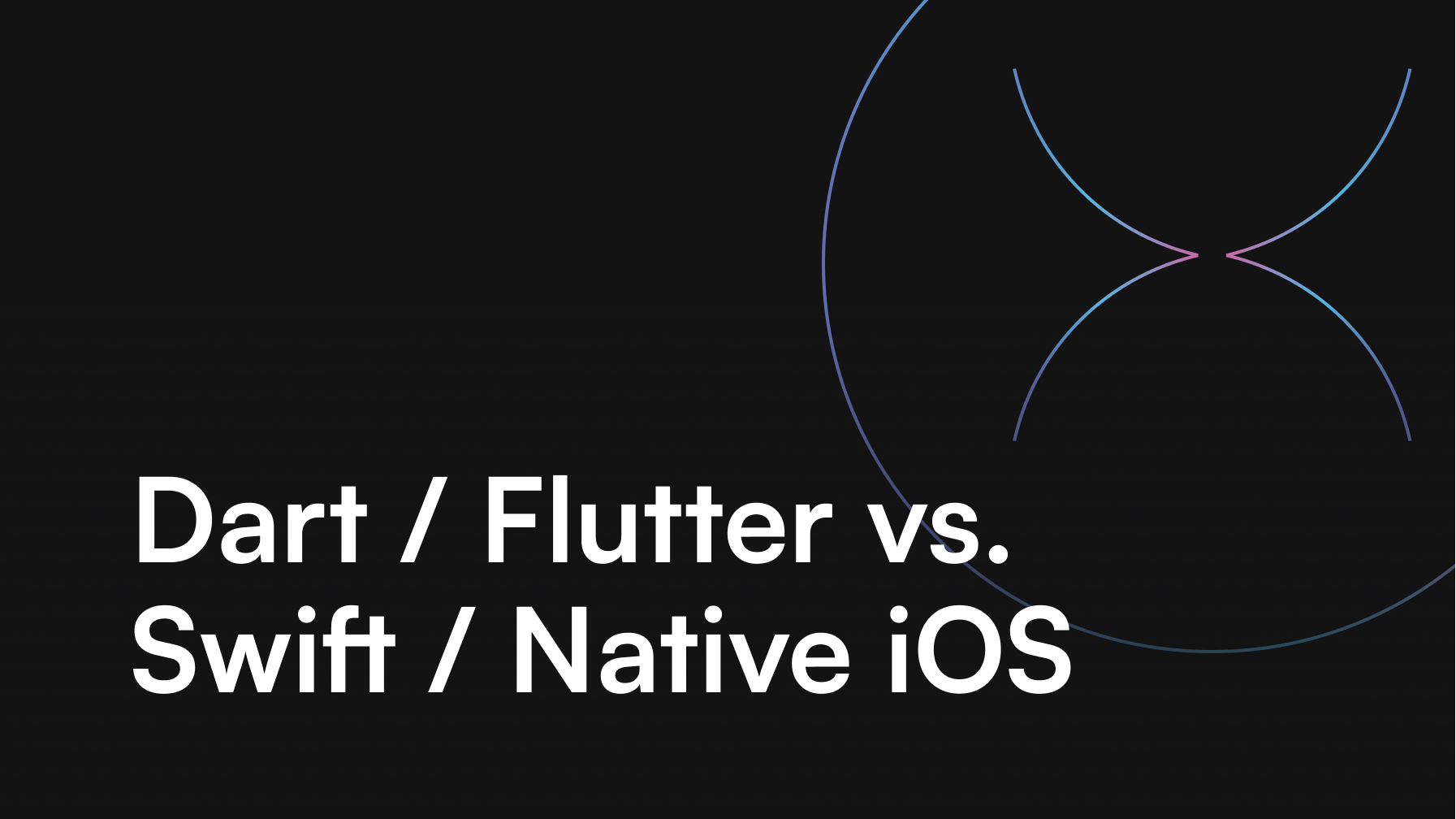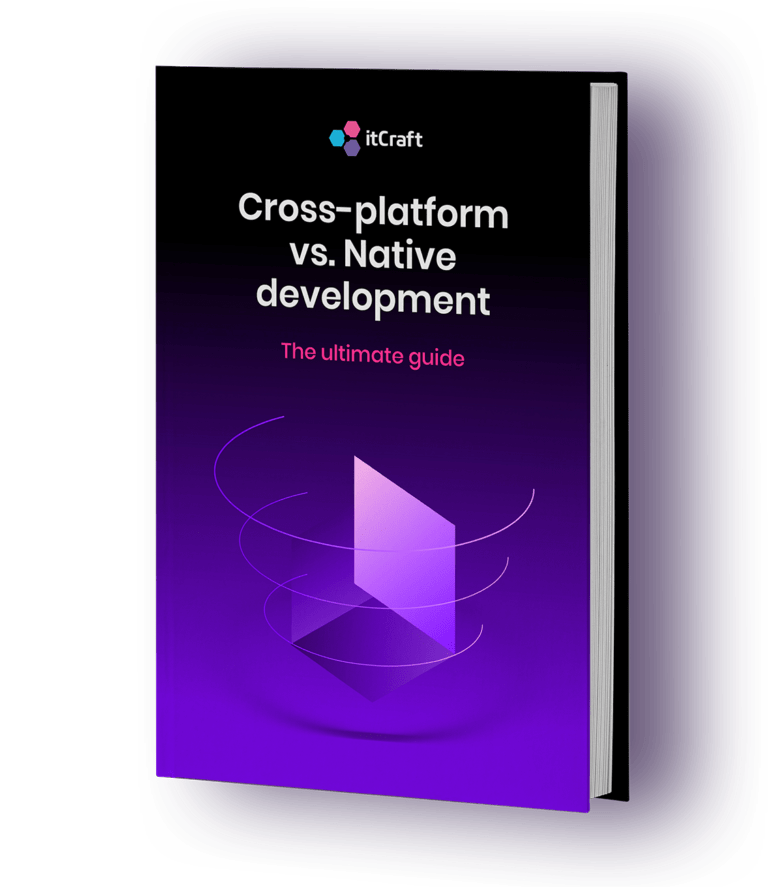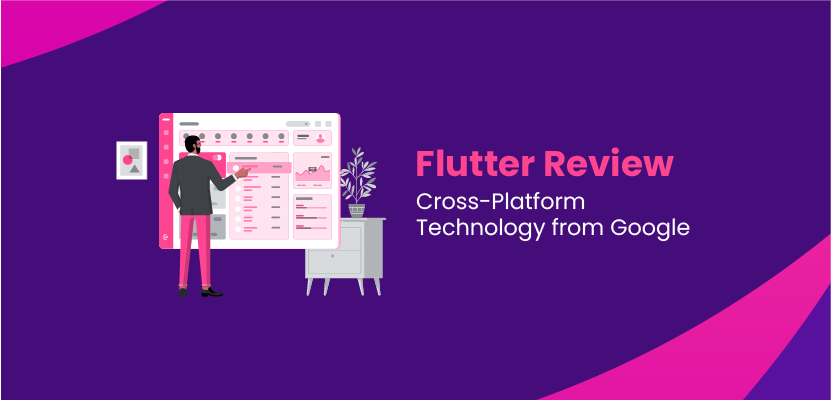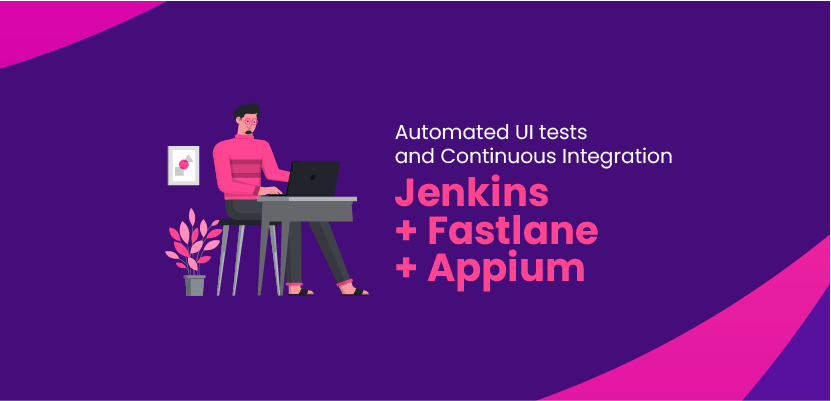Dart / Flutter vs. Swift / Native iOS – which one is better in 2021?

Alexa Trachim
Dart / Flutter vs. Swift / Native iOS – which one is better in 2021?

The debate over programming languages and frameworks seems never to end. Everyone wants to know which technology is best for writing code and producing exceptional, user-friendly mobile applications. As you can probably guess, there is no right answer to the question of “which software technologies are the best?” Each programming language offers different ranges of functionality. Ultimately, the main goal is to deliver applications that work fast, look good and offer everything that the potential user needs.
Table of contents
- The difference between Dart and Swift
- A couple of opinions and stats
- Dart vs. Swift – which one is easier to learn?
- Swift vs. Dart – project comparison
- Comparison table – Flutter app vs. Native app for Apple devices
- Top alternatives to Flutter and Native iOS
- Do you need a reliable IT partner?
This article will compare two very programming languages that gained popularity in recent years – Dart vs. Swift. In 2021, the knowledge about the benefits and drawbacks of a framework or a programming language is essential to determine which will be the most suitable for a particular project. There is no “one size fits all” solution, but there are times when one choice is much better than another.
Let’s dive into the world of two popular iOS programming languages to find out what are the differences between them and what kind of benefits they offer.
The difference between Dart and Swift
In programming, we can go in many different ways to achieve our objectives. Each of them can be slightly (sometimes significantly) varied. Here’s a short description of Dart and Swift so you can understand what they actually are and what their primary characteristics are.
What is Swift?
An open-source programming language developed by Apple dedicated to native iOS app development. It was released in 2014 and it became extremely popular, deposing Objective-C as the leading technology for building native iOS apps.
Swift is well-known for its innovative approach, speed of coding and thorough documentation. It is destined to provide security and high-performance rates for every piece of software built with it – as it is not dedicated only to mobile app development. Swift can be utilized for web, desktop and server apps, too. Every piece of hardware with an operating system from Apple, such as TVs, watches and iPads, uses software coded in Swift.
The primary environment used to build native apps with this programming language is XCode. Building software using Swift is claimed to be simple, fast and based on patterns that are known and loved by the community.
What is Dart?
Dart is a programming language released by Google in 2011. It can be used to build Android and iOS applications with a single codebase. This open-source mobile SDK (software development kit) is also becoming one of the popular mainstream technologies for mobile apps because the search for the ultimate cross-platform programming framework by developers and clients alike continues to be everyone’s white whale.
The primary environment for Dart is called Flutter – and that’s the reason the popularity of this programming language is growing. Flutter already became a market leader and is praised by developers. The community appreciates how the whole coding process is based on widgets that are compatible with each other. They are used in building reliable, eye-pleasing user interfaces. The documentation is well-written and detailed, which helps create new projects and offers support along the way.
Dart apps can give a native-like feeling for both Android and iOS with a single base of code – so it saves time and can cost less than building separate native apps for both iOS and Android. You already know a programming language for native iOS development – as for Android, that would be Kotlin or Java.
A couple of opinions and stats
According to the Slant community, Dart is better to learn as the first programming language – it was ranked #22, while Swift was #29. It also won regarding consistency and productivity. The dominance in the JavaScript compilation was significant – Dart was #12 and the native iOS technology was placed far away as #44. Dart also outran its competition from this article when it comes to server-side programming.
Native iOS developers noticed mostly Apple-related benefits – support from the tech giant and compatibility with all its devices. They also appreciated its modern syntax and fast performance. Dart supporters, on the other hand, shared their positive thoughts about asynchronous language support, multiple tools for more effortless coding and its resemblance to Java, which can make the learning curve easier.
Still, we need to remember that picking a particular option is a matter of preference, skills and project requirements. Native code won’t be better than cross-platform if its quality is low. When picking a solution, we shouldn’t consider its popularity but its capabilities. That’s why in this article you will get tons of useful facts about these two options – this way, you will be able to determine which to choose. We have years of experience when it comes to software creations, so you can trust our judgment.
Dart vs. Swift – which one is easier to learn?
To really compare two technologies or frameworks, we need to find out how easily developers can adapt them. This way, we can tell if becoming a Swift developer or Dart developer requires the same amount of time and effort.
Apple claims that Swift is a programming language that is easy to learn. There are many different opinions, but to be fair, learning Swift gives the developer a solid base for coding native iOS apps. This type of specialization can be beneficial for some types of projects that require native iOS development. It is worth mentioning that there are games that teach kids (but not only!) how to develop iOS apps – an example would be Playground. If you would like to learn Swift, give it a try. That is the basic method to start programming in this language and the demand for developers who know it is still high.
When using Flutter, we get a toolkit that allows us to build iOS and Android apps simultaneously. Since many clients are looking for quick time-to-market options and their budgets are not always adequate for separate native mobile apps, Dart offers a significant advantage.
Answering the question about the learning process is not that easy because Swift and Dart are entirely different languages. Each of them has its own coding rules, uses various techniques and additional tools, and both are suited to slightly different types of projects.
For some developers, Swift is the method they choose when building an iOS application. For others, Dart is better, especially since it allows multi-platform development, which can be useful in many mobile app projects.
Swift vs. Dart – project comparison
Many articles compare iOS app development using the same app made with Swift and Dart. They take lots of factors into consideration to determine the differences in iOS development using these two technologies. Let’s see if Dart and Swift have any common attributes and where they diverge most.
Onboarding / Installation
The first step in building an iOS app is the onboarding process. That means installing an IDE (integrated development environment) program that will provide an SDK (software development kit) to begin coding.
For Swift, that would be XCode, which needs to be installed on the macOS device. That’s the only tool required for essential native iOS development with Swift.
Dart requires a much bigger toolkit. We use XCode, and an IDE like IntelliJ IDEA or Android Studio and a Mac device to make a Dart binary that is used for coding.
Swift requires fewer tools than Dart, but according to our developers at itCraft, who work on native iOS app projects, both are pretty easy to configure. It depends on preferences.
Testing
Testing a Dart app and Swift app is much different, but both options are effective and have a solid base.
When it comes to Dart, it has a testing system that allows us to create many types of tests, including UI and functional level tests. The developer can write tests that will be performed by the Dart driver.
In Swift, testing native iOS mobile apps is simple. It has its own testing framework called XCTest that allows us to test UI modules, integration, performance and much more.
Both technologies offer excellent testing environments to provide advanced documentation and, as an outcome, an iOS app that delivers.
Build time
Build time (how long it takes to create the app file) might be one of the most critical factors, especially for developers. In this case, usually clean builds (without derived data and incremental builds) are compared to determine if Swift or Dart is faster. Improved build-time means that developers can focus on adding new features to the system quicker and more efficiently (as they don’t waste a lot of time while the code is being compiled).
Both Swift and Dart have their respective commands to measure the build time of clean builds. The best way to do that is to use XCode that is used in both technologies to develop native iOS apps.
Native programming languages like Swift or Kotlin (for Android) are always considered faster when it comes to building native apps. These claims are not wrong. For a Swift project that takes 12 seconds to make a clean build, it may take Dart about three times longer. But it is worth mentioning that additional Dart builds will take less time as the framework speeds up after the initial clean build.
It is also worth mentioning that build time is critical for big projects because as the codebase size increases, so does the period it requires to be built.
App reloading
Adding new features to an iOS app requires reloading and testing it with a device or a simulator. While doing this, the developer can evaluate the code and see how the changes influence the whole app. It’s one of the main steps in the app projects.
Dart uses hot reload functionality, so seeing changes in the Dart app takes only a couple of seconds. Dart is considered much faster when it comes to introducing changes in the code.
In native iOS app development with Swift, changing one feature like a button name requires renaming the interface part and rebuilding native code to test if the change is reflected within the app when running it on a simulator or a device. It usually takes around 12 seconds. Now SwiftUI allows hot reloads, and we can also use non-native solutions like InjectionIII to add new functionalities quickly.
Profiling
Profiling measures the performance of an iOS app. It focuses on memory, CPU and resources. Native tools are not the only ones that offer promising profiling when it comes to iOS. Dart is also stable in that matter.
In Swift, we can use XCode, which offers a tool that allows the analysis of the iOS app using available criteria. There are several templates used for different profiling tests – for example, Time Profiler will enable us to measure CPU threads by clicking the button multiple times.
Dart provides excellent documentation on Dart app profiling. We can use an IDE (like Intellij IDEA, for example) or use a command line. By doing this, we can display the time needed for Dart app profiling.
Although the profiling’s length depends on the app itself, native tools are usually faster at this task.
Integration
iOS app development requires integration for speeding up the process of building an app.
An app written with Swift can use the macOS devices with installed XCode – like XServer or Jenkins – to integrate regularly. Dart app integration is based on Nevercode, which uses a Codemagic CI/CD tool to make the integration seamless.
Accessibility
App accessibility is an important subject. In iOS development, it refers to apps with user experience facilitation for people with disabilities. Each mobile app should be accessible to everybody, so Dart and Swift need to support these functionalities.
Accessibility support is much better within Swift than Dart. iOS native owns a UIKit that has these features built-in, so developing them is simple. Dart documentation recommends using XCode’s Accessibility Inspector to provide it, but it doesn’t have any internal support for these features whatsoever.
App size
The final ground of comparison is the size of the final result. Dart iOS apps tend to be massive when it comes to size. That’s due to the size of the Dart engine – apps can’t be smaller than a particular value. So if, for some reason, the weight of your app matters, we should definitely approach native Swift development.
Comparison table – Flutter app vs. Native app for Apple devices
| What? | Flutter | Native |
| Programming language | Dart | Swift |
| Popularity | 110K stars on Github | 54.7K stars on Github |
| Cross-platform | Yes | No |
| Accessibility | Limited support | Full support |
| Onboarding | XCode + IDE | Just XCode |
| Build time | A dozen seconds | A couple of seconds |
| App size | Bigger | Smaller |
| Reloading | Faster (approx. 3 sec) | Slower (approx. 7-13 sec) |
Is Dart better than Swift?
Should we pick Flutter or native programming language when our goal is to develop an app for Apple devices? There is no obvious answer to that. Although native solutions tend to showcase many advantages, Dart would be the best choice to create a product for multiple platforms – both an iOS app and an Android app.
As a relatively new but already popular framework, Flutter will definitely continue to grow and improve as the development community expands. Its benefits for cross-platform development are undeniable and ignoring it as an app development tool would be a huge mistake.
iOS apps can be created in many ways. An experienced software house with core competencies in multiple programming languages and frameworks will always propose the best solution depending on the project requirements, the size and the time and budget. At itCraft, we always recommend whether to create native iOS apps or use Flutter. Advice is based on the desired business objectives and user expectations. Results and business growth is how we measure success, no matter if we are working together with a startup or a big enterprise.
Top alternatives to Flutter and Native iOS
You have to remember that there are many programming languages we can choose from when building an app. Everything depends on your goals and needs – especially on the number of platforms and the complexity of the features you want to implement.
Usually, clients want to develop an app for the two most popular operating systems – Android and iOS. If they want an app just for one – which rarely happens and in the future won’t probably be the case anymore – a native solution can be a better choice. For Android, that would be Kotlin or Java and for iOS – Swift or Objective-C. That’s because these programming languages offer advanced features, excellent speed and the possibility to use hardware functions like a camera and GPS.
But if you want to be present for the majority of your potential clients, you shouldn’t pick just one platform. This is the moment when you start to wonder if you should use a framework for multi-platform app development or go with two separate native products. The best way to determine which direction you should follow is to consult a software house like itCraft. Throughout the years of the market, we did multiple projects for various industries. We will recommend an appropriate tech stack based on your business plan.
As for top alternatives to technologies we described in this article, you should check out other popular solutions like React Native – the biggest competitor to Flutter. We also create web apps with leading web technologies like Angular or Vue.JS.
Do you need a reliable IT partner?
We encourage you to contact us so we can discuss your next iOS project. Our developers use Dart / Flutter, native programming languages like Swift and Kotlin, JavaScript, React Native and many other innovative technologies that follow current trends when it comes to mobile development. Furthermore, we even make innovative products using machine learning and AI! The key to success is a team of professionals that understand goals and pains related to your business. Let’s work together!

Would you like to know more about differences between cross-platform and native app development? Download our ebook! It is the ultimate guide to Cross-Platform vs Native development. You will find out more about native applications, cross-platform applications and technologies used to build them.






